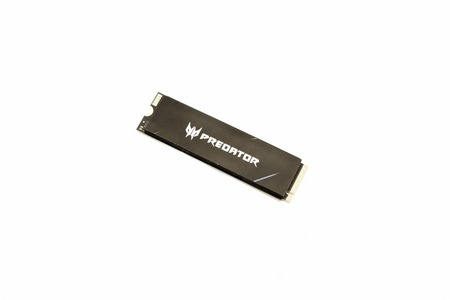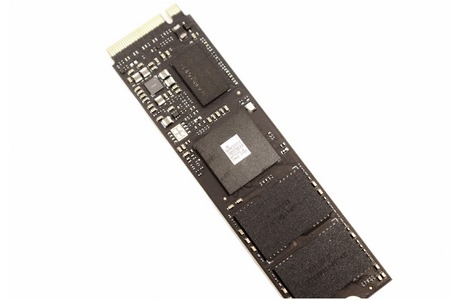INTRODUCTION

As we wait for the very first PCIe 5.0 compatible motherboards to make their debut it's clear to everyone that PCIe 4.0 has surpassed all expectations in terms of read and write performance for internal storage media and more specifically Gen4 M.2 NVMe v1.4 solid state drives. Also, if you've been keeping tabs on PCIe 4.0 (Gen4) SSDs then you should be well aware that Phison currently leads the market (at least in terms of sales) with their high-performance PS5018 (E18) eight-channel NAND flash controller. Still Phison is far from the only manufacturer to have a high-performance consumer oriented PCIe 4.0 (Gen4) NVMe v1.4 compatible NAND flash controller, for example Samsung, Intel and Micron have their very own and then there's also Silicon Motion and Innogrit. The latest model by Acer (BIWIN) is the Predator GM7000 and as you've probably guessed already it uses a NAND flash controller not manufactured by Phison.
Predator branded storage products are designed and manufactured by BIWIN Storage Technology company, a leading maker of quality flash memory, DRAM memory and solid-state drives (SSDs). Delivering premium products for serious gamers and overclocking enthusiasts looking for the ultimate experience, our mission is to provide best-in-class memory modules and solid-state drives that enhance overall system performance and gameplay. Defined by faster speeds and gaming-inspired design, these Predator storage products are built to be the Number One choice for gamers worldwide. Founded in 2010, BIWIN focuses on providing global customers with high-quality storage products and specializes in the research, development, manufacturing and sales of memory chip application products.
The Predator GM7000 line of M.2 NVMe v1.4 SSDs includes 3 different capacities (512GB/1TB/2TB) and was supposed to be released late last year with Micron 96-layer 3D TLC NAND flash modules. Still the release of 176-layer 3D TLC NAND flash again by Micron (and in turn its performance gains) was way too appealing for BIWIN to ignore so the GM7000 was delayed and is now offered with that instead. Everything else however remains the same and so once again under the hood we find the Rainier IG5236 eight-channel PCIe 4.0 (Gen4) NVMe 1.4 NAND flash controller by Innogrit together with DDR4L DRAM flash by Nanya (512MB for the 512GB version, 1GB for the 1TB version and 2GB for the 2TB version) and the mentioned 176-layer 3D TLC NAND flash by Micron. This hardware combo gives the GM700 performance levels of up to 7400MB/s in reads and 6700MB/s in writes thus allowing it to go head-to-head with the E18 controller by Phison. The Rainier IG5236 controller also packs all the technologies you'd expect by the top-of-the-line consumer model by Innogrit including end-to-end data protection, LDPC (low-density parity check) error-correction with SRAM ECC, programmable RAID, smart cache, AES encryption, SHA, RSA, ONFI 4.1 and Toggle 4.0. Finally, BIWIN covers the entire line with a 5-year limited warranty, reports an MTBF of 2 million hours for all 3 models and as for endurance numbers they give 300TBW for the 512GB model, 600TBW for the 1TB and 1300TBW for the 2TB model.
SPECIFICATIONS AND FEATURES

PACKAGING AND CONTENTS
BIWIN ships the drive inside a small black box that has a partial product picture at the front along with the Acer Predator logo, capacity and genuine product sticker.
The product specifications are printed at the rear of the box right next to several certifications and a sticker with the product serial numbers and barcodes.
Aside the Predator GM7000 SSD inside the box you’ll also find an M.2 mounting screw and the quick start guide.
THE PREDATOR GM7000 2TB
The Predator GM7000 follows the typical M2280 standard (22mm in width and 80mm in length) and comes with a thick black sticker on top.
I was surprised to see that the thick black sticker is actually a graphene-laced foam pad which should help reduce temperatures.
Under the sticker we find the Innogrit IG5236 NAND flash controller, 1TB DDR4L DRAM module by Nanya and two Micron 176-layer 3D TLC NAND flash modules.
Turning the drive over we find another sticker with its capacity and serial numbers on it.
Under that sticker we find yet another DDR4L DRAM module by Nanya and two more 176-layer 3D TLC NAND flash modules by Micron.
TEST BED


TESTING METHODOLOGY
Not long after I first started testing SSDs back in 2008, I concluded that it's almost impossible for any single benchmark suite to accurately measure their performance and that's why in certain benchmark suites we see amazing read/write performance numbers with some drives while in others things are quite different. The reason behind this is that some benchmarking suites are configured to read and write random chunks of data while others read and write constant (sequential) ones. So that's why i always use a very wide selection of benchmarking suites including AIDA64, HD Tach RW, HD Tune Pro, Crystal Disk Mark, Sisoftware Sandra Pro, AS SSD, IOmeter and ATTO. To get the most accurate results each test gets repeated a total of 6 times with the average performance numbers recorded into the charts*/****. Also, as of February 25th 2015 our results will also include the Storage Networking Industry Association’s (SNIA) IOMeter tests. These tests include a 12 Hour write test used to “simulate” performance degradation over time and a mixed workload test which basically shows what you can expect when using an SSD continuously for roughly two hours. Unfortunately, due to the time required for these tests they get repeated a total of 3 times and not 6 as the above.
Many people have made inquiries about our charts in the past so once again please do keep in mind that the Charts have the average performance numbers of each drive recorded and not the peak (highest) ones. Also, although every single one of these programs can help potential buyers choose the right drive for their needs you should also remember that from any kind of benchmark up to real world usage the gap is not small (and usually most differences will go unnoticed by most people). All tests were performed in a fresh Windows 10 Pro x64 installation complete with every update up to the date of this review.
* Since November 2018 the SSD comparison charts have been divided to 2.5” and M.2 models to reduce their growing size.
** Unless stated otherwise the Ryzen 9 3950x based Test Rig used for M.2 Gen 4 SSD reviews is not located in the lab.
*** As of January 2021 for Gen 3x4 models I’ll be using the Core i9-7980XE test rig (after numerous tests the up to 6% difference in read & write performance compared to the i7-6700 system simply wasn’t enough to justify having an extra test rig around).
**** Since February 2022 M.2 NVMe Gen3 and Gen4 SSD drives are placed in different charts.
TEST RESULTS - AIDA64 / ATTO


TEST RESULTS - HD TACH RW / HD TUNE PRO


TEST RESULTS - SISOFTWARE SANDRA PRO / CRYSTAL DISK MARK


TEST RESULTS - AS SSD / IOMETER


TEST RESULTS - IOMETER SNIA

CONCLUSION

The Predator GM7000 M.2 PCIe 4.0 (Gen4) M.2 NVMe v1.4 SSD by BIWIN is the very first model to arrive in the lab that uses Innogrit’ s IG5236 eight-channel NAND flash controller so i was very curious to see how it would perform. Well, as you can tell from my charts the drive doesn’t disappoint since it produces some of the best read & write performance numbers I’ve seen to date. Now it’s not quite “better” compared to models that use the E18 controller by Phison (together with 176-layer NAND flash by Micron) but it does trade blows with them for the most part and that’s plenty in my book. Unfortunately, just like with most E18 based drives that have copper and/or aluminum stickers the graphene-laced foam pad used on the GM7000 was designed for light to medium loads so there clearly was quite a bit of thermal throttling during my IOMeter SNIA tests.
Price is the one thing I was worried BIWIN would not pay much attention at but I was wrong since at the time of this review the Acer Predator GM7000 2TB M.2 NVMe v1.4 SSD retails for just USD264.99 inside the USA (Amazon.com) and for 300.15Euros inside the EU (Amazon.de). This puts the Predator GM7000 on the lower end of numerous drives by Phison and other brands so I do expect it will do good in terms of sales. Bottom line the Predator GM7000 2TB has it all, performance, endurance, warranty and price and for that it gets the Platinum Award.

PROS
- Excellent Performance Levels
- Endurance (1300TBW / 2 Million Hours MTBF)
- 5 Year Limited Warranty
- Graphene Laced Foam Pad
- Price (For Some)
CONS
- Thermal Throttling (During SNIA Tests)

 O-Sense
O-Sense




















.png)

